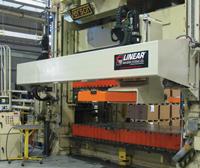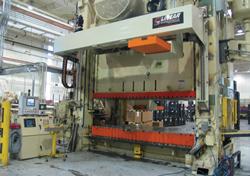- FMA
- The Fabricator
- FABTECH
- Canadian Metalworking
Categories
- Additive Manufacturing
- Aluminum Welding
- Arc Welding
- Assembly and Joining
- Automation and Robotics
- Bending and Forming
- Consumables
- Cutting and Weld Prep
- Electric Vehicles
- En Español
- Finishing
- Hydroforming
- Laser Cutting
- Laser Welding
- Machining
- Manufacturing Software
- Materials Handling
- Metals/Materials
- Oxyfuel Cutting
- Plasma Cutting
- Power Tools
- Punching and Other Holemaking
- Roll Forming
- Safety
- Sawing
- Shearing
- Shop Management
- Testing and Measuring
- Tube and Pipe Fabrication
- Tube and Pipe Production
- Waterjet Cutting
Industry Directory
Webcasts
Podcasts
FAB 40
Advertise
Subscribe
Account Login
Search
Retrofitting a prog-die press for transfer operations
Wringing more profit from an old press
- By Paul Stirrett
- May 13, 2008
- Article
- Bending and Forming

Click image to view larger. The press window has a direct relationship to the type of transfer system you select and how it is mounted to the press. Front- and rear-mount systems mount on any style of press, including one with no window.
Does this sound familiar? You purchased a new press 20 years ago for a specific program that ended seven years after the installation. The press was paid for during those years because it always was at capacity. For the past 13 years your management team has been finding projects to fit the press, but has never come close to hitting past production numbers. Your sales department cannot bid on new transfer jobs with one of your biggest customers because quoting hand transfer no longer is competitive. Last year you could have landed some high-volume takeover transfer work from a Tier 1, but it went to your biggest competitor, which has a servo transfer press.
Transfer Stamping Can Fuel Growth, Expand Markets
This scenario is common across North America. Some stampers are considering stamping components using transfer dies rather than in progressive dies for the following reasons:
1. As OEMs decrease the number of components in each new program launch, the resulting complexity of the new parts often indicates that they must be made in a transfer die.
2. Material savings can justify using transfer dies because blanks can be nested. Zigzag feeders are used in many applications to maximize the number of blanks coming off the coil, minimizing scrap.
3. Because a change can be done with one hit in a transfer station, as opposed to tearing out multiple stations in a progressive die, changes are simpler. This accommodates the possibility of engineering changes in the future.
4. Some flanging and cam operations can be performed more easily in a transfer die than a prog die. For example, the ability to rotate a part gives die designers creative freedom not possible in a progressive-die operation.
5. Today's servo transfer systems are more flexible, faster, and smoother than they used to be. The drive trains are modular and scalable and no longer should be the bottleneck in the stamping process. Some servo transfers are designed to retract up and out of the way for die changes or to run progressive dies (see Figure 1). With a proper transfer retrofit, an old press can become a fully programmable transfer press capable of running any part profile that can fit in that press and at rate.
6. Many old hand transfer or mechanical transfer systems run at 25 percent to 50 percent of the speed they would run in a servo transfer. The potential for higher speed provides the opportunity to pick up takeover jobs from these programs and run them efficiently and profitably in a servo transfer.
Required Press Characteristics for Successful Transfer Retrofit
So, let's say you have decided to buy a transfer press. Before specifying a new press, look at your current presses to see whether you can modify any of them into a transfer press. Retrofitting a servo transfer system on the wrong press could be disastrous if not properly thought out. You should consider these factors when choosing a press for retrofitting:
1. Bed length and tonnage. Your sales department should know your current and potential target markets to help you assess desired bed length and tonnage. The current trend for the transfer retrofit market is for longer beds and higher tonnage so that additional stations can be added. Longer beds facilitate coil feeding and blanking in the first stations, which eliminates the need for offline blanking and the purchase of a destack feeder.

Figure 1Front- and rear-mount servo transfer systems can be designed to swing out of the way during die changes or when the press is running progressive dies.
2. Press stroke. In a progressive-die press, the shorter the stroke, the faster the press runs. In a transfer press, this is not always the case. A transfer system runs more efficiently when a sufficient stroke window allows the transfer the time it needs to make its moves when the die is not engaged. Your transfer system vendor should look at the type of parts you plan to run and make recommendations on a press with a sufficient stroke. Drive-sizing software provides estimates on run rates if the following data is entered: lift, pitch, and grip per side; part weight; die engagement; and press stroke.
3. Press window. The press window has a direct relationship to the type of transfer system you select and how it is mounted to the press (see sidebar). When the servo retrofit market went into full swing in the mid-1990s, most of the automation suppliers were mounting their transfers through the press window. This design still is efficient and has some advantages, but front- and rear-mount systems also are an option.
4. Press control upgrades. Control upgrades may be required for safety or expansion purposes. Safety upgrades include guarding, such as light curtains or fencing. Upgrades also can expand press operation features and reliability depending on the press vintage. The older the press, the more the control system will require attention.
5. Mechanical upgrades. A modern transfer can physically mount on any press. The press design dictates the mounting location. Modifications to accommodate the transfer may include relocating piping or electrical services after you have determined the transfer's location.
6. Safety upgrades. After you have modified the press to accept a transfer, you need to upgrade the overall safety circuit to the latest standard. Local laws and safety authorities, such as the Occupational Safety and Health Administration (OSHA), dictate the extent of the modifications.
Make the Most of Your Equipment
It is good business to maximize the use of older (paid for) capital equipment. Leasing companies treat servo transfers as capital equipment, which can free up initial cash requirements for financing the automation. Many stampers that have retrofitted their older presses into transfer presses have experienced a growth curve in their bottom lines and increased their customer's confidence in their capabilities.
Mounting System Types—Advantages, Disadvantages
When looking at mounting options, you may want to consider the pros and cons of window-mount systems and front- and rear-mount systems.
Window-mount—Advantages(seeFigure 2)
- It occupies minimal space around the press as it is mostly positioned inside the press columns.
- An efficient design allows it to move less of its own mass than a front- and rear-mount transfer.
- It has bars running only through the die area, which is wide open for accessibility when it is time for die maintenance and finger adjustment.
Window-mount—Disadvantages
- The small press window restricts how wide the parts are that can be run.
Front- and Rear-mount—Advantages
- It mounts on any style of press, including one with no windows.
- It has fully independent head control.
- It has a larger range of motion than a window mount, with infinite passline adjustment and no restrictions because of window size.
- It can be adapted to accept emergency or takeover work bars and fingers from other transfer systems.
- The deflection rates tend to be less than with a window system because the transfer rails are held at points in the center.
- Robust design capabilities allow heavy payloads to run at maximum rates.
Front- and Rear-mount—Disadvantages
- It takes up more room on the front and rear of a press, which can be a disadvantage with rolling bolsters and overhead crane die changes. Longer tracks are needed to ensure that the bolsters extend past the transfer's footprint.
- Rails typically don't extend through the columns, which can give a window system a slight advantage as it can continue to walk the part out of the press on idle stations if desired.
About the Author
subscribe now

The Fabricator is North America's leading magazine for the metal forming and fabricating industry. The magazine delivers the news, technical articles, and case histories that enable fabricators to do their jobs more efficiently. The Fabricator has served the industry since 1970.
start your free subscription- Stay connected from anywhere

Easily access valuable industry resources now with full access to the digital edition of The Fabricator.

Easily access valuable industry resources now with full access to the digital edition of The Welder.

Easily access valuable industry resources now with full access to the digital edition of The Tube and Pipe Journal.
- Podcasting
- Podcast:
- The Fabricator Podcast
- Published:
- 04/16/2024
- Running Time:
- 63:29
In this episode of The Fabricator Podcast, Caleb Chamberlain, co-founder and CEO of OSH Cut, discusses his company’s...
- Trending Articles
Capturing, recording equipment inspection data for FMEA

Tips for creating sheet metal tubes with perforations

Are two heads better than one in fiber laser cutting?

Supporting the metal fabricating industry through FMA

Omco Solar opens second Alabama manufacturing facility

- Industry Events
16th Annual Safety Conference
- April 30 - May 1, 2024
- Elgin,
Pipe and Tube Conference
- May 21 - 22, 2024
- Omaha, NE
World-Class Roll Forming Workshop
- June 5 - 6, 2024
- Louisville, KY
Advanced Laser Application Workshop
- June 25 - 27, 2024
- Novi, MI



























